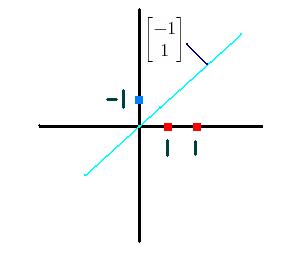We have 3 points. The labels are shown in the figure.
Writing the Equation for the dual problem:

$ Q(\alpha )= {\alpha }_{1}+{\alpha }_{2}+{\alpha }_{3}-[0.5{{\alpha }_{1}}^{2}+0.5{{\alpha }_{2}}^{2}+2{{\alpha }_{3}}^{2}+2{\alpha }_{2}{\alpha }_{3}] $
Subject to constraints
$ -{\alpha }_{1}+{\alpha }_{2}+{\alpha }_{3}=0 $
and $ {\alpha }_{1}\geq 0; {\alpha }_{2}\geq 0;{\alpha }_{3}\geq 0 $ Differentiating partially with respect to $ {\alpha }_{1},{\alpha }_{2}, {\alpha }_{3} $
$ 1-{\alpha }_{1}=0 $
$ 1-{\alpha }_{2}-2{\alpha }_{3}=0 $ $ 1-2{\alpha }_{2}-4{\alpha }_{3}=0 $
We always use the constraint equation, and then use 2 of these three equations. On solving, we get
$ {\alpha }_{1} = 1 $ $ {\alpha }_{2} = 1 $ $ {\alpha }_{3} = 0 $
b=0
Thus, we get a line through the origin with slope 1. This is the same boundary as was expected.



